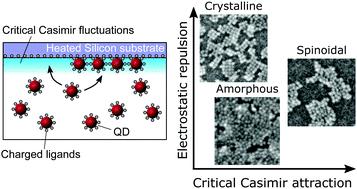当前位置:
X-MOL 学术
›
Nanoscale Horiz.
›
论文详情
Our official English website, www.x-mol.net, welcomes your
feedback! (Note: you will need to create a separate account there.)
Controlled deposition of nanoparticles with critical Casimir forces
Nanoscale Horizons ( IF 8.0 ) Pub Date : 2021-05-28 , DOI: 10.1039/d0nh00670j Emanuele Marino 1 , Oleg A Vasilyev , Bas B Kluft , Milo J B Stroink , Svyatoslav Kondrat , Peter Schall
Nanoscale Horizons ( IF 8.0 ) Pub Date : 2021-05-28 , DOI: 10.1039/d0nh00670j Emanuele Marino 1 , Oleg A Vasilyev , Bas B Kluft , Milo J B Stroink , Svyatoslav Kondrat , Peter Schall
Affiliation

|
Nanocrystal assembly represents the key fabrication step to develop next-generation optoelectronic devices with properties defined from the bottom-up. Despite numerous efforts, our limited understanding of nanoscale interactions has so far delayed the establishment of assembly conditions leading to reproducible superstructure morphologies, therefore hampering integration with large-scale, industrial processes. In this work, we demonstrate the deposition of a layer of semiconductor nanocrystals on a flat and unpatterned silicon substrate as mediated by the interplay of critical Casimir attraction and electrostatic repulsion. We show experimentally and rationalize with Monte Carlo and molecular dynamics simulations how this assembly process can be biased towards the formation of 2D layers or 3D islands and how the morphology of the deposited superstructure can be tuned from crystalline to amorphous. Our findings demonstrate the potential of the critical Casimir interaction to direct the growth of future artificial solids based on nanocrystals as the ultimate building blocks.
中文翻译:

具有临界卡西米尔力的纳米粒子的受控沉积
纳米晶体组装是开发具有自下而上特性的下一代光电器件的关键制造步骤。尽管做出了很多努力,但迄今为止我们对纳米级相互作用的有限理解推迟了组装条件的建立,导致可重复的超结构形态,因此阻碍了与大规模工业过程的整合。在这项工作中,我们展示了通过临界卡西米尔引力和静电斥力的相互作用在平坦且无图案的硅基板上沉积一层半导体纳米晶体。我们通过蒙特卡罗和分子动力学模拟通过实验和合理化展示了这种组装过程如何偏向于 2D 层或 3D 岛的形成,以及如何将沉积的超结构的形态从晶体调整为非晶态。我们的研究结果表明,关键的 Casimir 相互作用具有指导未来基于纳米晶体作为最终构建块的人造固体的生长的潜力。
更新日期:2021-07-16
中文翻译:

具有临界卡西米尔力的纳米粒子的受控沉积
纳米晶体组装是开发具有自下而上特性的下一代光电器件的关键制造步骤。尽管做出了很多努力,但迄今为止我们对纳米级相互作用的有限理解推迟了组装条件的建立,导致可重复的超结构形态,因此阻碍了与大规模工业过程的整合。在这项工作中,我们展示了通过临界卡西米尔引力和静电斥力的相互作用在平坦且无图案的硅基板上沉积一层半导体纳米晶体。我们通过蒙特卡罗和分子动力学模拟通过实验和合理化展示了这种组装过程如何偏向于 2D 层或 3D 岛的形成,以及如何将沉积的超结构的形态从晶体调整为非晶态。我们的研究结果表明,关键的 Casimir 相互作用具有指导未来基于纳米晶体作为最终构建块的人造固体的生长的潜力。











































 京公网安备 11010802027423号
京公网安备 11010802027423号